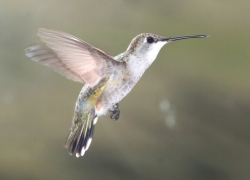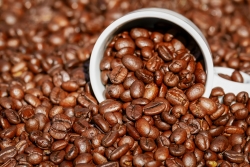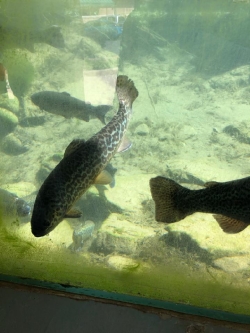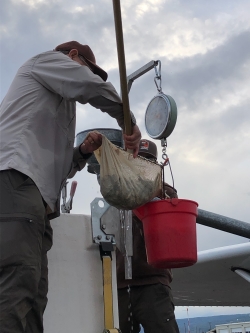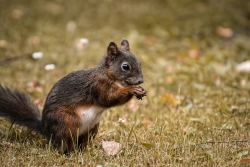
Courtesy Pixabay
I’ve watched red squirrels manipulate fir cones with their front paws with amazing dexterity. Like myself eating a cob of corn, it spun the cone rapidly while shredding the cone scales to access the seed. Their tiny toes grip the cone identically to my fingers gripping the cob of corn. I’m amazed how they can unerringly navigate their way from tree to tree through our forest. There are many examples of squirrel intelligence witnessed by animal behaviorists.
Arboreal squirrels often build dreys that look like bird nests. Dreys are made up of twigs , moss, feathers and grass. All the items surrounding the dreys provide support and insulation. Chimpanzees exhibit very similar behavior.
Squirrels make use of several vocalizations to communicate with each other, they also create scents to attract opposite sex or communicate. They can create signals with their tails as well, by twitching it to alert other squirrels on the presence of a potential danger.
Tree squirrels display fantastically acrobatic movements, phenomenal adaptability to urban environments, and possess very cute little faces to boot. The 7th International Colloquium on Arboreal Squirrels was held 2018 in Helsinki, Finland. Studies routinely come discover new, amazing behaviors, especially involving the squirrel’s signature behavior, that it buries caches of its food to access later. One experiment found that they’ll try multiple tactics to open a locked box. Another found that squirrels remember the location of their caches without using their keen noses to locate them. Another found that they’re able to quickly learn from their peers.
A 2010 study found that squirrels actually engage in deceptive, or paranoid, behavior. When squirrels are being watched, they’ll construct fake caches, pretending to bury a nut by digging a hole, patting it down with their front teeth, and scraping dirt or grass over the top of it while concealing the nut in a pocket near their armpit, and will make the real cache somewhere else. Even while watching, it can be difficult to tell when a squirrel is making a fake or a real cache. How smart is that?
A study was conducted at UC Berkley in which students were placed in a competitive game to act like squirrels. They hid caches of plastic eggs, and then 15 minutes later returned to find them. This is a very squirrel-like test: memory, deception, location, observation, paranoia. Most students couldn’t remember their own hiding places. Squirrels bury about 10,000 nuts per year, making many different caches, and may not uncover them for months. They may dig up a cache and bury it somewhere else, and do that up to five times. Squirrels, unlike UC Berkeley students, are engaged in this intellectually draining activity while also avoiding predators and braving the elements.
This is Jack Greene for Bridgerland Audubon. I’m Wild About Utah and its amazing squirrels!
Credits:
Picture: Courtesy Pixabay, Alexas Fotos, Photographer, https://pixabay.com/photos/squirrel-rodent-animal-cute-nature-5158715/
Audio: Courtesy UPR
Text: Jack Greene, Bridgerland Audubon, https://bridgerlandaudubon.org/
Additional Reading: Lyle W Bingham, Webmaster, and Jack Greene, Author, Bridgerland Audubon, https://bridgerlandaudubon.org/
Additional Reading:
Jack Greene’s Postings on Wild About Utah, https://wildaboututah.org/author/jack/
Utah Fox Squirrels, NHMU is studying Fox Squirrels, and we need your help!, Natural History Museum of Utah, https://nhmu.utah.edu/citizen-science/utah-fox-squirrels
Types of Squirrels in Utah! (3 species w/ pictures), Bird Watching HQ, https://birdwatchinghq.com/squirrels-in-utah/

